Once again about Verdun. French look
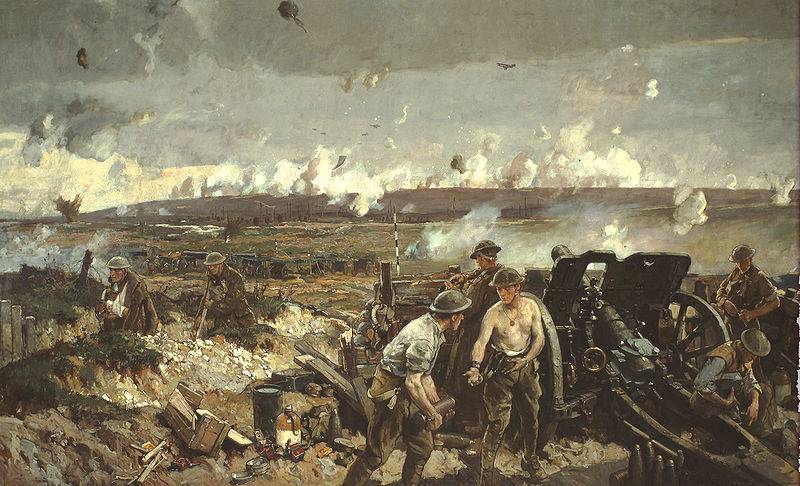
В stories World War I holds a special place in the battle of Verdun. Just as Stalingrad became a symbol of the defeat of the Wehrmacht by the Soviet Army, the battle of Verdun was the forerunner of the defeat of the German troops. For the French, Verdun was forever a symbol of the struggle against Germany for the honor and independence of France. It is the French view of this battle that will be the basis of the article.
At the start of 1916, the Allied position in Europe was far from overwhelming. The French army suffered heavy losses in the unsuccessful 1915 battles of the year. In addition, her forces were dispersed: she fought also in the East, against Turkey and Bulgaria. Affected by the lack of modern heavy artillery. The British and Belgian forces interacting with the French army were not enough.
The German command, expecting that in the summer of 1916, the Entente countries would undertake a broad offensive in the main theaters of military action, decided to preempt the Entente with the attack near Verdun and strengthen the prestige of Germany that was shaken after the defeat on Marne in the eyes of its allies. The plan of the Germans was to chain the French troops, to attract the forces of the Entente countries to this sector of the front and, forcing them to defend themselves, thus draining the French army, using their superiority in artillery. The Germans hoped that, after suffering heavy losses, the French army would not be able to conduct offensive operations on the Somme. An offensive with the same objectives was planned against the Italian troops in the region of Asiago. In this way, the German command intended to thwart the plans of the Entente for the 1916 summer campaign of the year. The Germans also chose this sector of the front for the offensive because the fortress Verdun was the key position of the French defense.
Over the centuries-old history of France, Verdun was besieged many times. In the Gallic War, it was besieged by the Romans, in 450, it was destroyed by Attila, in 843, it gave the name to the famous treaty that divided Western Europe into three states.
Among the numerous attacks to which the fortress was subjected, the events of 1792 of the year should be noted, when 44 artillerymen with 32 guns fiercely attacked the Prussian army for a long time. In 1870, Verdun, whose garrison consisted of 1500 people and 2000 or 3000 partisans, put up courageous resistance to Prussian troops of 10 thousand people. After a two-month siege, the city surrendered on honorable terms.
After the Franco-Prussian War of 1870, Verdun became one of the key positions of the main line of defense, consisting of forts, strongholds, artillery batteries. Therefore, in the 1914 year, when the German armies invaded Belgium and advanced in the direction of Paris, Verdun played an important role in the fighting of the French forces aimed at stopping the enemy attack on Marne.
After the stabilization of the front line, the Germans sought to isolate the Verdun ledge associated with the rear of only one rail and one highway. Until 20 February, 1916 was a local battle near Verdun that did not bring success to either side. At a time when the German army was already preparing an offensive near Verdun, the French command ordered to disarm the belt of forts due to the fact that in August 1915, a decree was adopted to create fortified areas instead of the existing line of fortresses. Verdensky fortified area was to consist of field-type fortifications — trench positions, field fortifications — batteries and barbed-wire barriers pushed beyond the line of forts, which ran 7-8 km from the main fortress. On the front, the fortified area of Verdun stretched for 112 km and was divided by the river Meuse into two sectors on both sides of the Meuse. The depth of the defense was four positions, the first of which defended from the line of forts on 5-7 km. 54 batteries and all the armaments of the casemates were removed from all positions. Disarming the forts, the French, contrary to logic, began before the new defense system was created.
The German command concentrated six corps, 1225 guns (of which around 700 were heavy and super heavy) and 152 mortar to master the Verdun fortified area. The enemy had the 14 railways, and the German artillery kept under fire its guns not only the city, but also the Verdun-Saint-Ménéoul railroad that remained in the hands of the French and the Verdun-Bar-le-Duc highway. French troops in this sector of the front consisted of three army corps and 632 guns.
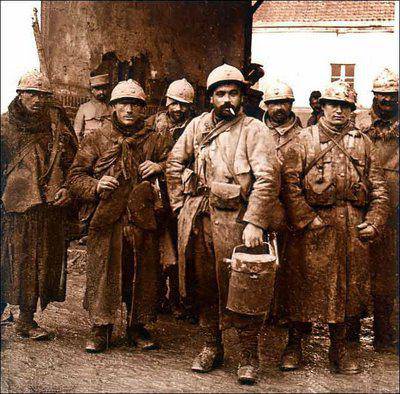
The idea of the Germans was to destroy the French fortifications with heavy and super heavy artillery, deliver the first strike on the right bank of the Meuse, and then launch an attack against the positions of the left bank and in a short time capture the fortress of Verdun. Everything seemed to foreshadow the quick success of the German offensive, but the fierce resistance of the French army overthrew the plans of the enemy.
Fearing to expose the front on the Somme, where the offensive was being prepared, the commander-in-chief of the French army, Joffre, ordered the troops defending Verdun to hold the right bank of the Meuse at any cost. For six months the garrison of Verdun, having extremely limited forces and means, fought with the superior forces of the enemy. The battle of Verdun is divided into four phases:
- 1 (February 21 - 4 March 1916 of the year) - a sudden German strike on the right bank of the Meuse River;
- 2 (March 4 - 9 of the year 1916) - the fierce attacks of the Germans on both sides of the Meuse with the aim of wearing down French forces;
- 3 (June 9 - October 24 1916) - the resumption of the German offensive on the right bank of the Meuse (before September 2) and the subsequent transition to defense;
- 4 (October 24 —18 December 1916) - the French forces launched a counteroffensive.
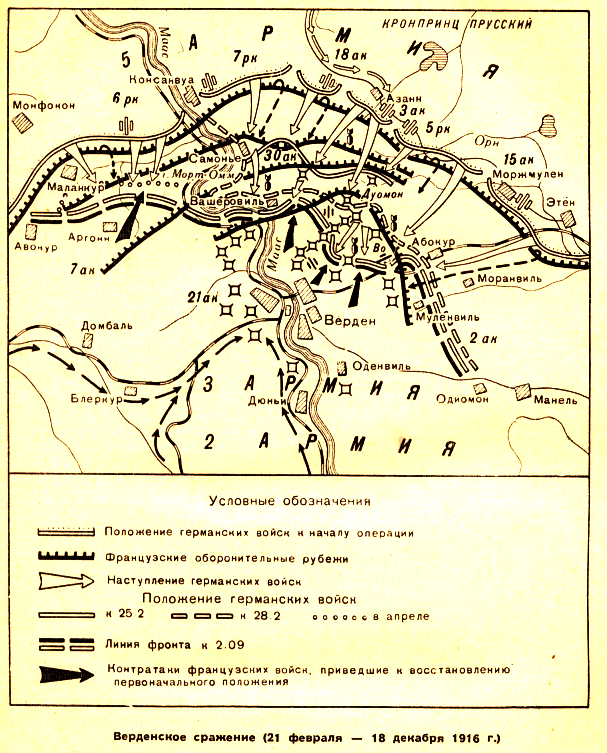
1 th stage. Germans attempt to break through the front with a sudden and powerful blow
On the morning of February 21, 1916, the Germans began artillery preparation throughout the Verdunsk front. The systematic and strong shelling of the first line of the French defense was complemented by heavy artillery fire directly along the fortress and the villages north-west of it. In 16 hour. 45 min. German infantry launched an offensive on the 40-kilometer front and attacked the French positions on the right bank of the Meuse.
The German command counted on such a sudden, powerful and deep blow to crush all resistance of the French. However, it miscalculated. The French soldiers successfully repelled attacks by three times their superior enemy. For example, the arrows, which occupied positions in the forest Décor, heroically repelled the German attacks for two days. 22 February, the enemy subjected this forest to a fierce bombardment, but the French, led by Colonel Drien, stood to death, repelling in melee combat - four consecutive attacks. They stayed until they received an order to leave their positions and move to the village of Beaumont. One of the participants of the reflection of the attack later said: "After the shelling of artillery, the destruction was such that we could not find out the surrounding area."
February 23 after a fierce battle, the Germans broke through the first position of the French defense, and on February 25 the enemy captured the fourth position and the largest fort Duomon. Despite the fact that the forces were unequal (the French side had 36 infantry battalions and 210 guns against the 72 battalions and 800 enemy guns; in addition, they were the first to use 200 aircraft for a massive strike), the French managed to withstand, did not allow a breakthrough enemy to Verdun.
During the five-day fierce fighting, the units and formations that defended the Verdant fortified area, sustaining heavy losses, completed their task: they gave the main command time to tighten up reserves (20, 1, '13' s corps) and organize a defense on the left bank of the Meuse. On the night of February 26, Verdun’s defenders learned that the French command had formed the 2 Army under the command of General Petain from the reserves that had come up. To ensure the supply of 13 battalions were aimed at restoring the highway Bar-le-Duc, Verdun. Subsequently, this road played a huge role in the defense of Verdun (its capacity was brought to 1700 trucks per day) and was called the “sacred road”.
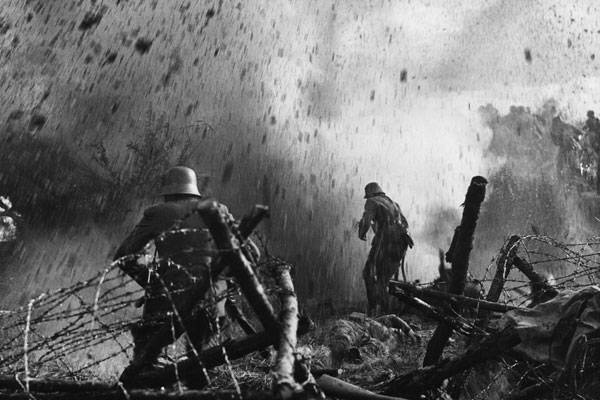
2 th stage. General offensive on the whole front
Realizing that the rate of surprise had failed, the German command, after two days of preparation, launched an offensive along both banks of the Meuse. On March 6, two German divisions attacked the 67 French division defending along the left bank of the Meuse in the Betencourt-Forge sector. They managed to capture Forge and Reneval, and 7 in March captured the village of Côte-de-Vaux. On the right bank of the Meuse, the enemy launched an offensive by the forces of five army corps. After a bloody battle, he approached Fort Woo, but he failed to master it, although on March 9 the fall of this fort was announced throughout Germany.
10 and 11 March The Germans violently attacked the fort of Vaud. On the slopes leading to the fort, and the wire obstacles there were piles of the dead (enemy losses in the personnel of the attacking units reached 60 percent). 16 and 18 March after a strong artillery preparation, the Germans again tried to seize the fort, but to no avail. His garrison, lacking food and water, continued to fight for three months. Only 2 Jun. Garrison commander W. Major Renal allowed several units to leave the fort. The remaining defenders, despite the use of flamethrowers and suffocating fumes by the enemy, continued to resist even when the Germans broke into the ruins of the fortifications. Hand-to-hand fighting in the fort continued until June 7. In his last report, his commander conveyed: “We have reached the end. Officers, sergeants and soldiers fulfilled their duty. Long live France! ”
The fierce resistance of the garrison of Vaux and other French formations and units forced the Germans to stop the massive attacks for a long time, in which they suffered heavy losses and spent a lot of ammunition. March 10, the commander-in-chief of French troops, in an address to Verdun’s defenders, emphasized: “For three weeks now, you have been sustaining the most powerful onslaught that the Germans have never used against us. Germany hoped for the success of this strike, which seemed irresistible to her, she laid its execution on the best troops, the most powerful artillery. The capture of Verdun was supposed to raise the spirit of its allies and convince neutral states of the invincibility of Germany. But she miscalculated. The eyes of the fatherland are now fixed on us. It will say about you: "They blocked the path of the Germans to Verdun." On April 9, the Germans launched a fierce attack along both banks of the Meuse. Several divisions participated in it, but they did not succeed and were rejected. The order for the 2 Army noted: “The ninth of April will be a glorious day for us ... Infantrymen, artillerymen, sappers and pilots of the second army competed in heroism. Glory to all. The Germans, of course, will still attack. Let each of us fight and strive to achieve the same success as yesterday. Do not lose heart - we will win them. "
In the next two months, the struggle continued with the same bitterness. The French repelled all German attacks. The attempts of the enemy to break through the defense ended in failure. Fierce melee again and again flared up on both sides of the Meuse. Some forts, such as Tiomon, and positions repeatedly passed from hand to hand. Fierce fighting continued until August 15.
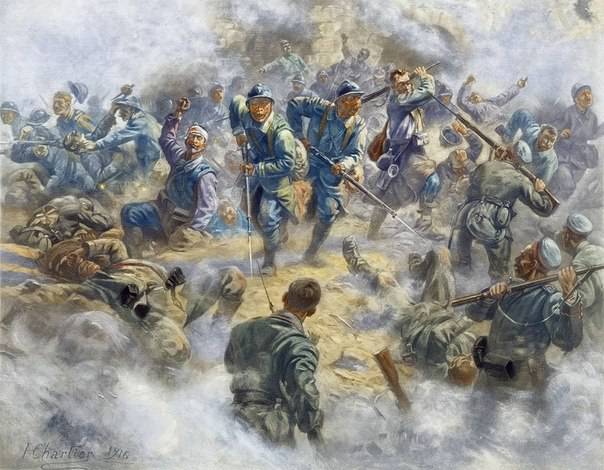
3 th stage. The resumption of the German offensive on the right bank of the Meuse
As already mentioned, in the summer of 1916, the Entente countries planned to launch a general offensive on the Somme, as well as on the Russian front. Knowing these plans, the German command decided to put an end to Verdun, who diverted considerable forces of the German troops. Not having achieved success in the general offensive, the German command again turned to the original plan: to strike at the fortifications on the right bank of the Meuse.
The bloody, stubborn battles began again, in which the French soldiers displayed real selflessness. So, during one of the German attacks on the farm of Tiomon, the 3 th company of the 137 Infantry Regiment suffered heavy losses. The remaining handful of soldiers from 11 to 13 Jun repulsed all German attacks and even captured prisoners. Despite the strongest fire of enemy artillery, the French soldiers attacked enemy positions with rifles in their hands, but they all died.
The intensive artillery bombardment of 21 June also went down in history, when the Germans fired tens of thousands of gas shells. The Bavarian divisions that went over to the attack were able to bypass the first defense position, but were stopped by units of the reserve of the French army. The breakthrough of the German front by the Russian troops near Lutsk in June 1916 of the year forced the German command to transfer part of the troops from under Verdun to the Eastern Front. After that, the intensity of the fighting in the area of Verdun decreased. The attacks of the Germans began to be private. This allowed the French troops to create starting points for large-scale counterattacks. By the end of August, the German losses already exceeded the losses of the French. The German command, which had found itself in an embarrassing situation after the start of the Russian offensive, decided to cease active operations and focus its efforts on strengthening the captured positions.
4 th stage. French counterstrikes
By early September, the offensive operations of the German forces near Verdun ceased. This made it possible for the French to prepare and deliver several powerful counterattacks against the enemy. The French commanders sought to capture the commanding heights on the banks of the Meuse and the forts captured by the enemy. From 19 to 25 in October, French artillery subjected German positions to heavy shelling (330 thousand 75-mm projectiles and 100 thousand 150-mm projectiles were spent), and on October 22, the French launched a false attack in order to identify the positions of numerous enemy batteries.
October 24 at 11 hour. 40 min. three French divisions under cover of dense fog launched an offensive on the 7-kilometer front. The German counterattacks were not successful, and the French managed to capture Fort Duomon and the surrounding terrain, which for several months was in the hands of the enemy.
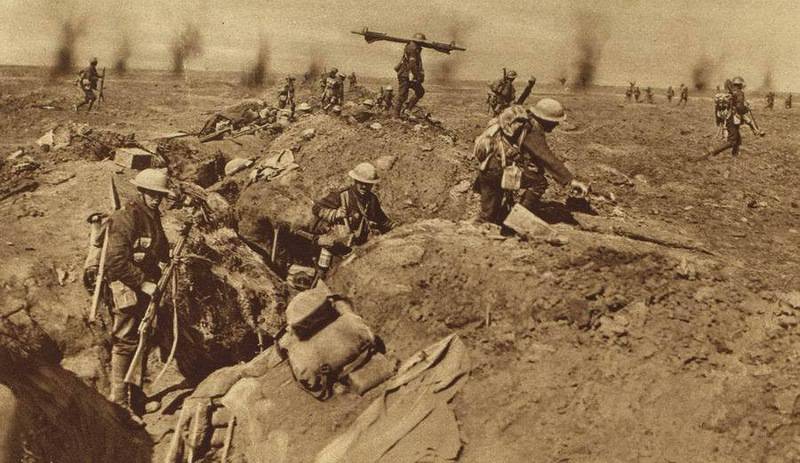
December 15 1916, after four days of artillery preparation, the French launched a new counter-strike. Despite the desperate resistance and counterattacks of the Germans, French troops captured the line of Maas heights and forts of Ardton. German troops in this area suffered heavy losses (6 divisions were defeated, 11 thousand people were captured, 115 guns were captured). The German command was forced to admit that "the fighting near Verdun between October and December turned out to be major and annoying failures." After that, the Verdun front, there was a lull, which lasted until August 1917, when French troops struck the final blow to the enemy. The Germans, constrained by the active hostilities of the Allies in Flanders and on the Isonzo River, left positions captured near Verdun.
20-21 August, the French troops restored the front line on the same line from which they had withdrawn two years ago.
Verdun battle was a moral victory for the French and contributed to a turning point during the war. The battle of Verdun is considered by the French to be the bloodiest in the history of their wars. For nine months of fierce fighting, artillery raids of extreme power, massive use aviation, the use of toxic substances, the losses of both sides amounted to about 950 thousand people (350 thousand French and about 600 thousand Germans).
Sources:
Basil Liddell Garth. 1914. The truth about the First World War. M .: Eksmo, 2009. C.167-183.
Peten A.F. Defense of Verdun. Reprint Edition. SPb .: Polygon, 1994. C.12-74.
Priyr. Battle of Verdun // VIZH. 1973. No.8. C. 36-40.
A. A. Strokov. Armed forces and military art in the First World War. M .: Voenizdat, 1974. C.352-365.
Shatsillo V. The Last War of Tsarist Russia. M .: Eksmo, 2010. C.176-184.
Information